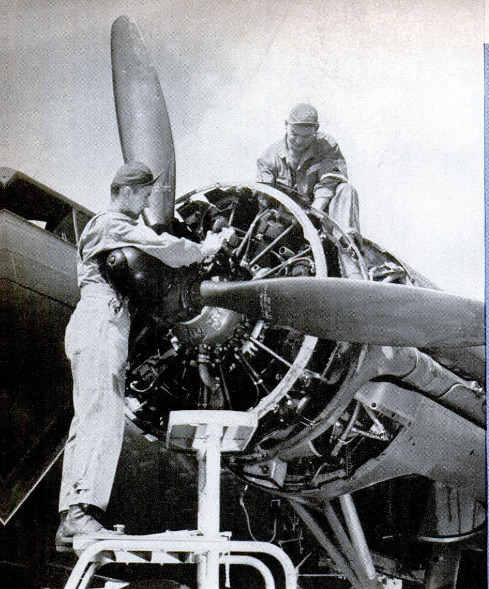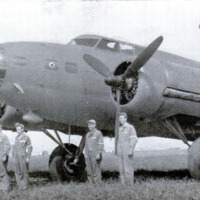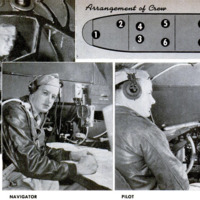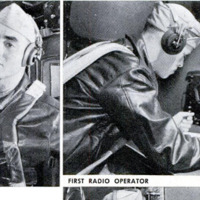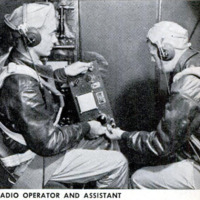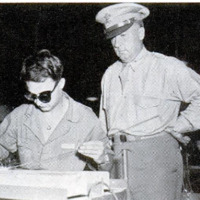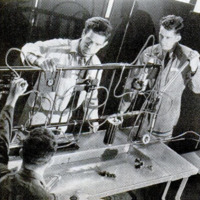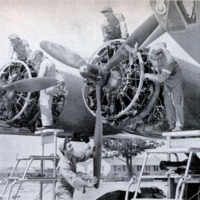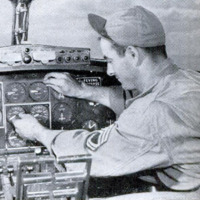-
Title (Dublin Core)
-
Boss of the big bomber
-
Article Title and/or Image Caption (Dublin Core)
-
Title: Boss of the big bomber
-
extracted text (Extract Text)
-
THREE years ago he was a young, raw
Army recruit. He knew a little about
mechanics and practically nothing
about soldiering. Today he is the “boss”
of a big bomber, the aerial engineer of a
B-17 Flying Fortress, and that ship is his
career—an Army career that has given
him the schooling and experience to fit him
for the same sort of job on a transoceanic
clipper or a big commercial land plane when
the emergency is over.
He doesn’t pilot a plane and he wears
only the stripes of a technical sergeant, but
he is an important man in the Air Corps.
He knows every rivet and gauge in the
bomber he grooms and broods over. Wheth-
er it is in the air or on the ground it is his
ship. The Army concedes that, and it is
just as well, for the aerial engineer would
not relinquish his proprietary rights in a
plane for all the armed forces of the nation.
The mechanization of the Army has not
dehumanized it. Every Flying Fortress with
its four engines, its wing spread of 103 feet,
and its rudder that stands 20 feet high,
demands the complete understanding of one
man and that man is its aerial engineer.
The Army realizes this dependence and is
providing for the care of the monsters which
are being turned out in increasing numbers.
Enlisted men who are to be their nurses
already are assigned to the factories where
they are taking form, watching their de-
velopment from embryo.
‘Westover Field in western Massachusetts,
the $9,000,000 base for the heavy bombard-
ment groups of the Northeastern States on
which work was started 18 months ago, is
an example of the demand there is going
to be for aerial engineers. Westover has
only a few Flying Fortresses now; within
a year it will have between 100 and 200,
each of them dependent upon the affection-
ate and vigilant care of one man.
The Army is searching out these men and
training them. Some of them are still raw
recruits at $21 a month, getting their first
six weeks’ training in the rudiments of
soldiering. Some time during this six weeks
the recruit gets an aptitude test which will
show whether he is mechanically inclined
or otherwise.
That is the first step. The man whose
test shows a decided mechanical bent gen-
erally gets an opportunity to request as-
signment to the ground crew of an air
squadron. If he already has his eye on the
rating of aerial engineer, he asks for as-
signment to a transport, reconnaissance, or
heavy-bombardment outfit instead of to an
attack or pursuit squadron.
If his request is granted, he goes to the
squadron as a recruit and has the chores
of a recruit to do during his sizing-up
period. He gets kitchen-police and guard-
duty assignments, fatigue details, and po-
lices the field in general. He may be at these
jobs for days or weeks, and then comes an
opportunity to go to school and take a
course in aerial mechanical engineering
which would cost him at least $900 if he
undertook it independently.
First he takes an intelligence test and
then an examination in mathematics. The
examination is thorough and will reveal
any weakness in fractions, decimals, ratio
and proportion, square root, or elementary
algebra. When he has passed it he has the
choice of several courses in Army Air Corps
technical schools—airplane mechanics, air-
craft armoring, machining, metalworking
or welding, parachute rigging, photography,
radio operation and mechanics, Air Corps
clerical work, and weather observation.
Scores of schools in various parts of the
country are giving these courses. Some of
them are private aviation schools which the
Army took over as they were, retaining the
civilian teaching staff and putting an Army
officer in charge. Some are strictly military
institutions. Their Army students number
more than 100,000 annually. At some bases
a third of the personnel was absent in school
at a time. The students pay no tuition.
They get their Army pay and board and
lodging.
The airplane mechanic's course is the
one that leads to the job of aerial engineer.
It covers airplane construction principles,
maintenance and repair of a plane, its en-
gine and equipment, and the use of tools and
equipment in a hangar. The student is in-
structed in the operating principles and
repair of airplane instruments; the con-
struction principles and repair of the fuse-
lage, wings, and landing gear; the installa-
tion and care of de-icer equipment, hydrau-
lic systems, and pneumatic equipment; the
construction principles and repair
of propellers; the principle of the
internal-combustion engine; the
repair of storage batteries, gen-
erators, starters, spark plugs, and
wiring assemblies; and the tech-
nique of periodic plane inspec-
tions.
Graduates may take advanced
courses in the construction prin-
ciples and repair of carburetors
and airplane instruments, elec-
trical units and propellers, weath-
er forecasting and the care and
maintenance of the nation’s great
military secret, the American
bombsight. The bombsight, how-
ever, is not within the province
of the aerial engineer. Only two
men of the 250 in a squadron
handle that and they are chosen with the
strictest care.
The school graduate returns to his squad-
ron as an apprentice mechanic, generally
with the rating of corporal, and gets his
first chance to do some work on one of the
big bombers. Again, however, he finds him-
self a beginner, with only the humbler tasks
assigned to him—chiefly, at first, the wip-
ing up of oil. The aluminum pistons of a
Flying Fortress do not fit the cylinders
closely until the heat of the running engine
has expanded them and until then the
engine sprays oil, distributing about a quart
over everything within range.
Kerosene cannot be used in cleaning off
this oil because of its inflammability. The
apprentice mechanic has to use carbon
tetrachloride, a vexatious fluid which evap-
orates at the first swipe. The oil sprayed
by the bomber's engines leaves a film even
in places seemingly inaccessible, and the
apprentice mechanic hunting it down be-
comes familiar with every part of the en-
gine mechanism—battery, fuel booster
pump, tachometer drive, carburetor control,
and piston. Tt is his job, too, to change tires,
wipe windows, wash the fuselage, and use a
vacuum cleaner. Every inch of the ship be-
comes familiar to him and he knows where
everything belongs.
On the first Mondays of June and Decem-
ber there are tests in theory and practice
covering the ground the apprentice mechan-
ic went over in his school course and if he
passes these tests he can qualify for the
rank of air mechanic, a rating which may
increase his pay considerably. An air
mechanic, second class, draws $72 a month,
which is as much as a staff sergeant gets.
An air mechanic, first class, receives $84 a
month, the pay of a technical sergeant. The
air mechanic, however, may still rank only
as a private. An able apprentice mechanic
may be able to emerge from that classifica-
tion within three months and become an
engine mechanic, one of whom services each
of the four engines of a bomber.
Each engine mechanic has full charge of
his engine and full responsibility
for its performance. He examines
every part of it daily. After every
flying period of 54 hours he chang-
es spark plugs and cleans ofl and
fuel strainers and inverters. After
350 hours, plus 20 percent if per-
formance still is good, the supercharger is
removed. After 450 hours the engine is re-
moved and sent away to be rebuilt.
The rapid development of the military
airplane has resulted in so many changes
in construction that the Army Air Corps
is assigning its expert mechanics to the fac-
tories which are turning out equipment for
it, the Glenn L. Martin Company in Balti-
more; the Consolidated Aircraft Corpora-
tion in San Diego; the Lockheed Aircraft
Corporation in Burbank, Calif.; the Curtiss-
Wright Corporation and the Bell Aircraft
Corporation in Buffalo; the Douglas Air-
craft Company, Inc, in Santa Monica,
Calif, and the Pratt & Whitney Engine
Division and the Hamilton Standard Pro-
peller Division of the United Aircraft
Corporation in East Hartford, Conn.
In peacetime it took two or three years
for an engine mechanic to take the next
step in advancement, that to the post of
ground-crew chief. It may be done now in
a few months. The ground-
crew chief, who stands next
to the pinnacle of aerial engi-
neer, generally commands the
rating of technical sergeant
and is at the head of a crew of
20 men—the four engine me-
chanics and 16 apprentices.
He makes a detailed inspec-
tion of the ship every day and
scrutinizes each of the engines.
At 50 hours he checks the
brakes, removes the wheels
and inspects the bearings,
washing them and repacking
them. At 100 hours he takes
off the tires and examines
them with care.
It may be only two or three
weeks before a ground-crew chief
gets an appointment as aerial en-
gineer, but the appointment does
not depend entirely upon his abil-
ity as a mechanic or the care he
lavishes upon his ship. Two other
qualities are of prime importance.
He must be immune to airsickness |
and must have deadly accuracy with a ma-
chine gun. Like the rest of the enlisted per-
sonnel of a Flying Fortress, he must rate as
an expert gunner to have a seat in his ship
in flight.
The aerial engineer does everything for
his ship except fly it. He probably could
fly it in a pinch, since he is so thoroughly
familiar with it. Before the ship takes
off he inspects every part of it and starts
the engines. On the new B-24's he will have
his own instrument panel to synchronize the
power of the four engines. Technical Ser-
geant Arthur E. Chatfield of the 34th Bom-
bardment Squadron at Westover thinks that |
it’s the power of the engines that commands
the loving respect of the aerial engineer. :
“When the pilot gives it the gun,” he |
says, “and it snaps you back in your seat,
you know you've got Something there.
Boy, you can tell that you've got some
horses in front of you!”
-
Contributor (Dublin Core)
-
Barrett Mcgurn (article writer)
-
Language (Dublin Core)
-
Eng
-
Date Issued (Dublin Core)
-
1942-01
-
pages (Bibliographic Ontology)
-
90-95
-
Rights (Dublin Core)
-
Public domain
-
Archived by (Dublin Core)
-
Sami Akbiyik
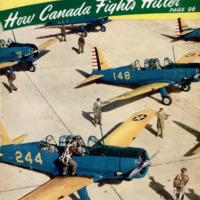 Popular Science Monthly, v. 140, n. 1, 1942
Popular Science Monthly, v. 140, n. 1, 1942

